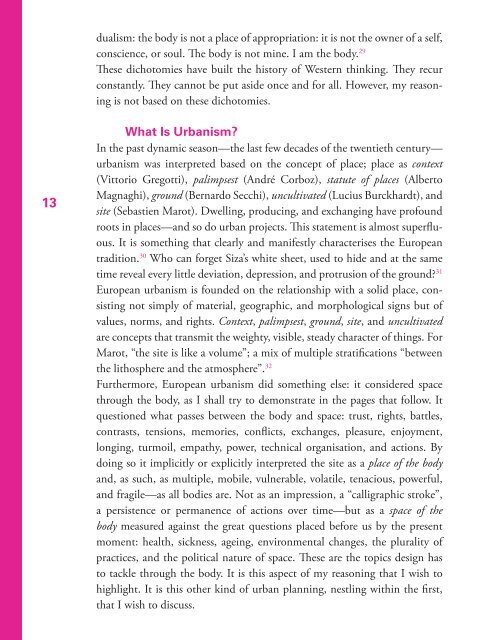You also want an ePaper? Increase the reach of your titles
YUMPU automatically turns print PDFs into web optimized ePapers that Google loves.
dualism: the body is not a place of appropriation: it is not the owner of a self,<br />
conscience, or soul. The body is not mine. I am the body. 29<br />
These dichotomies have built the history of Western thinking. They recur<br />
constantly. They cannot be put aside once <strong>and</strong> for all. However, my reasoning<br />
is not based on these dichotomies.<br />
13<br />
What Is Urbanism?<br />
In the past dynamic season—the last few decades of the twentieth century—<br />
urbanism was interpreted based on the concept of place; place as context<br />
(Vittorio Gregotti), palimpsest (André Corboz), statute of places (Alberto<br />
Magnaghi), ground (Bernardo Secchi), uncultivated (Lucius Burckhardt), <strong>and</strong><br />
site (Sebastien Marot). Dwelling, producing, <strong>and</strong> exchanging have profound<br />
roots in places—<strong>and</strong> so do urban projects. This statement is almost superfluous.<br />
It is something that clearly <strong>and</strong> manifestly characterises the European<br />
tradition. 30 Who can forget Siza’s white sheet, used to hide <strong>and</strong> at the same<br />
time reveal every little deviation, depression, <strong>and</strong> protrusion of the ground? 31<br />
European urbanism is founded on the relationship with a solid place, consisting<br />
not simply of material, geographic, <strong>and</strong> morphological signs but of<br />
values, norms, <strong>and</strong> rights. Context, palimpsest, ground, site, <strong>and</strong> uncultivated<br />
are concepts that transmit the weighty, visible, steady character of things. For<br />
Marot, “the site is like a volume”; a mix of multiple stratifications “between<br />
the lithosphere <strong>and</strong> the atmosphere”. 32<br />
Furthermore, European urbanism did something else: it considered space<br />
through the body, as I shall try to demonstrate in the pages that follow. It<br />
questioned what passes between the body <strong>and</strong> space: trust, rights, battles,<br />
contrasts, tensions, memories, conflicts, exchanges, pleasure, enjoyment,<br />
longing, turmoil, empathy, power, technical organisation, <strong>and</strong> actions. By<br />
doing so it implicitly or explicitly interpreted the site as a place of the body<br />
<strong>and</strong>, as such, as multiple, mobile, vulnerable, volatile, tenacious, powerful,<br />
<strong>and</strong> fragile—as all bodies are. Not as an impression, a “calligraphic stroke”,<br />
a persistence or permanence of actions over time—but as a space of the<br />
body measured against the great questions placed before us by the present<br />
moment: health, sickness, ageing, environmental changes, the plurality of<br />
practices, <strong>and</strong> the political nature of space. These are the topics design has<br />
to tackle through the body. It is this aspect of my reasoning that I wish to<br />
highlight. It is this other kind of urban planning, nestling within the first,<br />
that I wish to discuss.


















